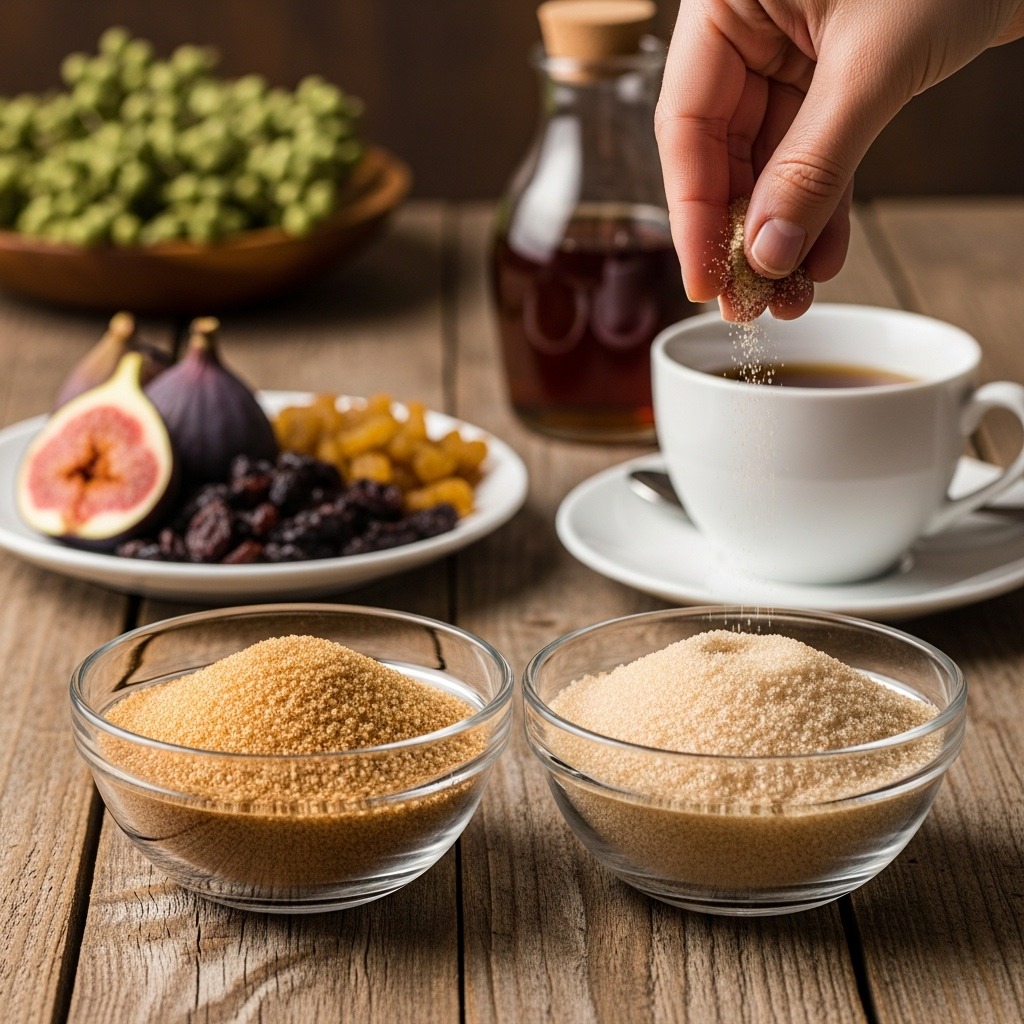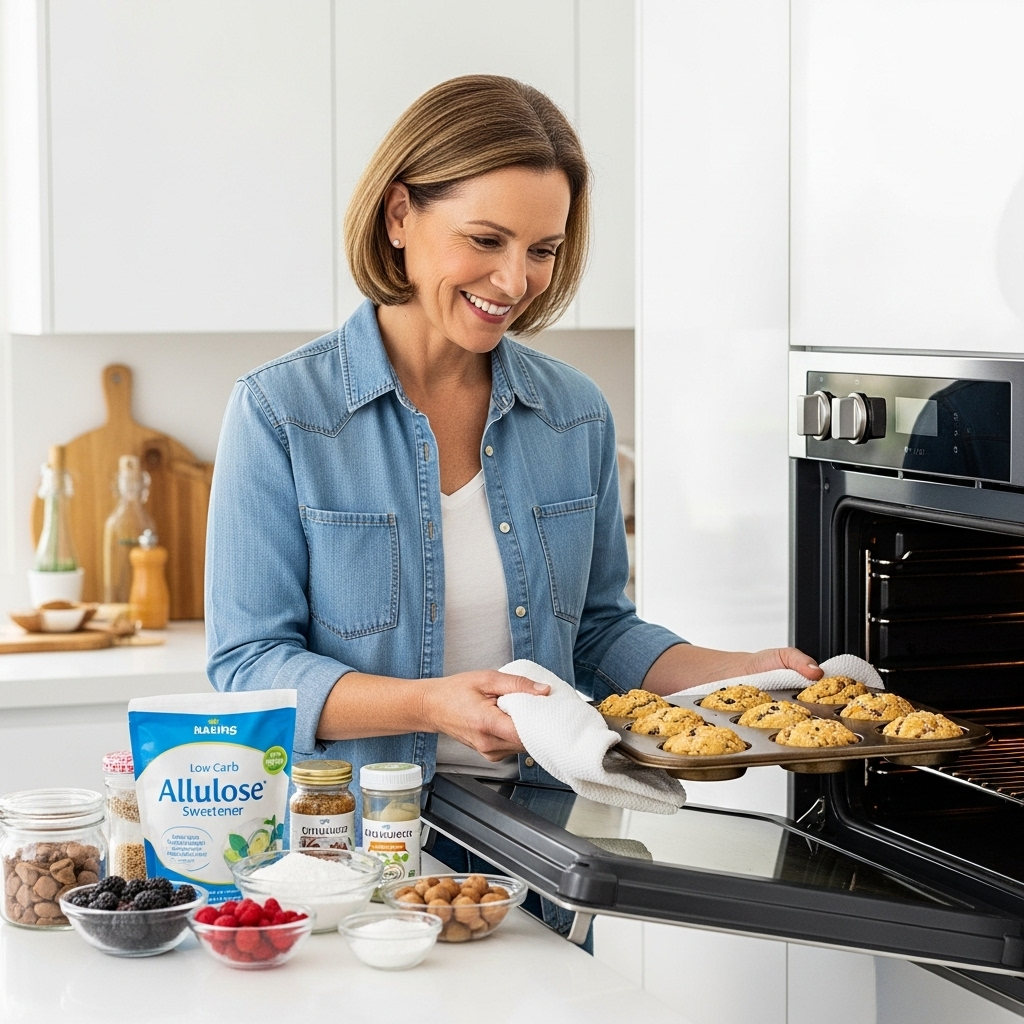In the world of diabetes management, finding sweeteners that don't spike blood glucose levels while still satisfying our natural desire for sweetness can feel like searching for a unicorn. But what if I told you there's a relatively new player in the game that's checking almost all the boxes? Enter allulose – a "rare sugar" that's generating significant buzz in the metabolic health community, and for good reason.
As someone deeply invested in metabolic health optimization, I've been closely following the research on alternative sweeteners. Allulose stands out as particularly promising for those managing diabetes or working to prevent it. Let's dive into what makes this sweetener special and why it might deserve a place in your pantry.

What Exactly Is Allulose?
Allulose (also known as D-psicose) is a monosaccharide that exists naturally in small amounts in certain foods like figs, raisins, and maple syrup. What makes it fascinating from a chemical perspective is that it's a stereoisomer of fructose – meaning it has the identical chemical formula, but its atoms are arranged differently in space. This seemingly minor structural difference dramatically changes how our bodies process it.
Despite looking and tasting remarkably like regular table sugar (about 70% as sweet), allulose behaves nothing like it metabolically. Here's the game-changer: allulose provides only about 0.4 calories per gram compared to sugar's 4 calories per gram. For practical purposes, that's roughly 1.6 calories per teaspoon instead of 16.
Even more importantly for those concerned with glucose management, allulose contributes zero net carbs to your diet. This is because our bodies absorb it but don't metabolize it for energy in any significant way – instead, most of it gets eliminated unchanged.

Metabolic Magic: How Allulose Works in Your Body
The metabolic behavior of allulose is what makes it particularly valuable for diabetes management:
Minimal Blood Glucose Impact
Unlike regular sugar or even fructose, allulose doesn't significantly raise blood glucose levels. This is crucial for anyone managing diabetes. When you consume allulose, approximately 70% gets absorbed in the small intestine and enters the bloodstream, but instead of being converted to glucose, it's primarily filtered by the kidneys and excreted unchanged in urine within about 24 hours. The remaining 30% passes through to the large intestine and is eliminated within approximately 48 hours.
This unique metabolic pathway means allulose doesn't require insulin to be processed, making it an excellent option for maintaining stable blood glucose levels.
Potential Metabolic Benefits
Beyond simply not raising blood sugar, emerging research suggests allulose may offer several positive metabolic effects:
-
Improved Insulin Sensitivity: Preliminary studies indicate allulose might enhance insulin sensitivity by affecting enzymes like glucokinase, which plays a crucial role in glucose metabolism. This could potentially help the body use insulin more effectively – a significant benefit for those with type 2 diabetes or insulin resistance.
-
Reduced Abdominal Fat: Some studies have shown modest reductions in abdominal fat with allulose consumption. This is particularly noteworthy because visceral fat (the kind that accumulates around organs) is strongly associated with insulin resistance and metabolic syndrome.
-
Liver Health Protection: Animal studies and limited human data suggest allulose may help reduce fat accumulation in the liver, potentially lowering the risk of metabolic associated steatotic liver disease (MASLD), a condition increasingly common in people with type 2 diabetes.
-
Appetite Regulation: Research indicates allulose may influence hunger hormones like GLP-1, PYY, and CCK – the same hormones targeted by some diabetes medications. These hormones help signal fullness, potentially reducing overall calorie intake.
Practical Considerations: Using Allulose in Daily Life
With its promising profile, you might be wondering how to incorporate allulose into your diabetes management strategy. Here are some practical considerations:
Dosage and Safety
For a healthy adult, safety studies suggest single doses up to about 0.4 grams per kilogram of body weight and daily totals up to 0.9 grams per kilogram are well tolerated. For a 70kg (154lb) person, that's about 28 grams in a single dose or 63 grams daily.
Exceeding these amounts increases the risk of digestive discomfort – primarily gas, bloating, or diarrhea – which represents the most common side effect. As with any dietary change, it's wise to start with small amounts and gradually increase as tolerated.
Culinary Uses
One of allulose's advantages over other alternative sweeteners is its behavior in cooking and baking. It browns and caramelizes much like regular sugar, making it excellent for:
- Baking low-carb desserts
- Sweetening beverages without affecting glycemic response
- Creating sauces and glazes that require caramelization
- Making homemade ice cream with improved texture (allulose lowers the freezing point like regular sugar)
In most recipes, you can substitute allulose one-to-one for sugar, though you might need slightly more to achieve the same sweetness level. Unlike some sugar alcohols like erythritol, allulose doesn't typically create a cooling sensation in the mouth or have a noticeable aftertaste.

Availability and Cost
Allulose is becoming increasingly available in grocery stores and online, though it remains more expensive than regular sugar or some other sweeteners. The cost reflects both its relative newness in the market and the more complex production process.
In terms of regulatory status, the FDA recognizes allulose as Generally Recognized As Safe (GRAS) in the United States. However, it's worth noting that regulatory approval is still pending in some regions, including Canada, Europe, and Australia, so availability varies globally.
Comparing Allulose to Other Sweeteners
When managing diabetes, the sweetener landscape can be confusing. Here's how allulose compares to other common options:
Allulose vs. Stevia
While both have minimal impact on blood glucose, many find allulose offers a more sugar-like taste without the aftertaste some detect with stevia. Additionally, allulose provides the bulk and functional properties of sugar in recipes, which stevia (being 200-300 times sweeter than sugar and used in tiny amounts) does not.
Allulose vs. Artificial Sweeteners
Unlike aspartame, sucralose, or saccharin, allulose is naturally occurring and not artificially created, though commercial allulose is produced through enzymatic conversion. Some evidence suggests artificial sweeteners might adversely affect the gut microbiome or paradoxically increase sugar cravings – concerns not currently associated with allulose.
Allulose vs. Sugar Alcohols (Erythritol, Xylitol)
Sugar alcohols also have minimal impact on blood glucose but can cause significant digestive distress in some individuals, especially at higher doses. Many people report better digestive tolerance with allulose compared to sugar alcohols, though individual responses vary.
The Bottom Line: Is Allulose Right for Your Diabetes Management?
For those navigating diabetes or working to prevent it, allulose represents one of the most promising sweetener options available today. Its minimal impact on blood glucose, potential metabolic benefits, and cooking versatility make it particularly valuable in a low-carb or ketogenic dietary approach.
That said, we should acknowledge the limitations of our current knowledge. While existing research is encouraging, most studies on allulose's metabolic benefits are still preliminary, often small in scale or conducted primarily in animal models. Long-term human studies are still needed to fully understand its effects.
As with any aspect of diabetes management, the decision to incorporate allulose should be personalized. Monitor your own glycemic response, consider your overall dietary pattern, and as always, consult with your healthcare provider about significant dietary changes, especially if you're taking medications to manage your blood glucose.
In a world where diabetes management often feels restrictive, allulose offers something refreshing – a way to enjoy sweetness with minimal metabolic downside. That alone makes it worth consideration as part of your metabolic health toolkit.
References:
-
Iida T, Kishimoto Y, Yoshikawa Y, et al. Acute D-psicose administration decreases the glycemic responses to an oral maltodextrin tolerance test in normal adults. Journal of Nutritional Science and Vitaminology. 2008;54(6):511-514.
-
Hossain A, Yamaguchi F, Matsuo T, et al. Rare sugar D-allulose: Potential role and therapeutic monitoring in maintaining obesity and type 2 diabetes mellitus. Pharmacology & Therapeutics. 2015;155:49-59.






